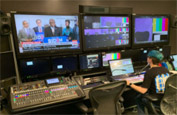Exploring the Benefits and Applications of PTZ Camera Systems
A PTZ (pan-tilt-zoom) camera system is a powerful surveillance tool that allows users to remotely control camera movement and zoom in and out to get a better view of a scene. This technology is widely used in various industries, including security, entertainment, education, and broadcasting. In this article, we will explore the features, benefits, and applications of PTZ camera system.
Features of PTZ Camera Systems
PTZ camera systems are equipped with advanced features that make them an ideal choice for surveillance and other applications. Some of the key features of PTZ Church Camera System:
Pan, Tilt, and Zoom: The ability to move the camera horizontally (pan) and vertically (tilt) and zoom in and out allows for a wide range of coverage and provides more detail when required.
Preset Positions: PTZ cameras can be programmed to move to specific locations and zoom levels, allowing the user to quickly and easily switch between views of different areas.
Automatic Tracking: Many PTZ cameras are equipped with automatic tracking capabilities that can follow moving objects within the camera’s range.
High-Definition Video: PTZ cameras can produce high-quality video footage with resolutions of up to 4K, ensuring that even the smallest details are captured.
Night Vision: PTZ cameras can be equipped with infrared sensors to provide clear images in low-light and nighttime conditions.
Remote Access: PTZ cameras can be accessed remotely, allowing users to view live footage and control camera movement from anywhere with an internet connection.
Benefits of PTZ Camera Systems
PTZ camera systems offer numerous benefits over traditional fixed-position cameras. Some of the key benefits of PTZ camera systems are:
Increased Coverage: PTZ cameras can cover a larger area than fixed-position cameras, making them an ideal choice for monitoring large spaces.
Enhanced Detail: PTZ cameras can zoom in and out to provide more detail when required, making them ideal for identifying individuals or reading license plates.
Flexibility: PTZ cameras can be easily repositioned and programmed to move to specific locations, providing greater flexibility in terms of camera placement.
Cost-Effective: PTZ cameras can be a more cost-effective solution than installing multiple fixed-position cameras to cover the same area.
Applications of PTZ Camera Systems
PTZ camera systems are used in a wide range of applications, including:
Security: PTZ cameras are commonly used in security applications to monitor large areas such as parking lots, shopping centers, and warehouses.
Entertainment: PTZ cameras are used in live events and broadcasts to provide a more dynamic and engaging viewing experience.
Education: PTZ cameras are used in classrooms and lecture halls to record lectures and provide remote students with a better view of the speaker.
Broadcasting: PTZ cameras are used in television studios to provide a more dynamic viewing experience for viewers by allowing for camera movement and zooming.
Traffic Monitoring: PTZ cameras can be used to monitor traffic flow and identify traffic violations, making them an ideal solution for law enforcement agencies.
Wildlife Monitoring: PTZ cameras can be used to monitor wildlife habitats and track animal behavior, making them an invaluable tool for conservationists and researchers.
Conclusion
In conclusion, PTZ camera systems offer a wide range of features and benefits that make them an ideal choice for surveillance, entertainment, education, broadcasting, and other applications. With their ability to pan, tilt, and zoom, PTZ cameras can cover a larger area and provide more detail when required, making them a more effective surveillance tool than traditional fixed-position cameras. Their flexibility, cost-effectiveness, and high-quality video output make them a popular choice across various industries. Whether you are a security professional, broadcaster, or conservationist.

Recent Post
What is The Meaning of a Medusa Tattoo?
January 9, 2025
The Meaning of Encanto in Spanish and Origin
January 4, 2025
Equivalent Phrases For “Including But Not Limited To”
December 30, 2024
How To Make Weekend Greetings More Fun?
December 30, 2024
10 Modern Sayings Similar To “Be There Or Be Square”
December 30, 2024








